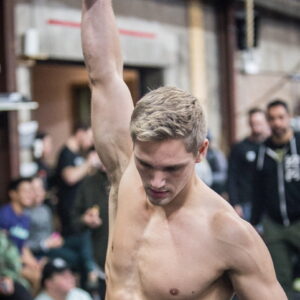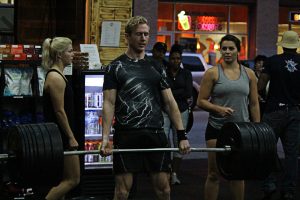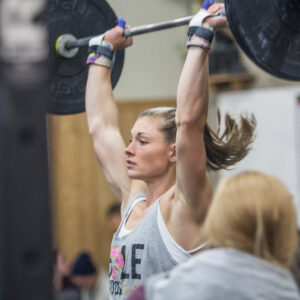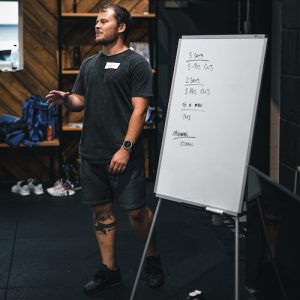We all know the athlete who can squat a house, but looks absolutely terrible while doing it.
One knee caves in, their upper back rounds, and they get stuck seemingly forever just coming out of the hole.
Would this athlete be stronger if they fixed all of their movement issues? Would they be less likely to get injured?
Maybe – although it’s difficult to say since they’ve likely “greased the groove” so many times with their altered mechanics, that they’ve adapted both neurologically and physically to their specific patterning.
However, if that athlete had taken the time when they first started training to learn to move “correctly,” I’m much more confident that they would, in fact, be stronger and more resilient.
We don’t just compensate with ugly movement patterns, though. We can compensate in conditioning workouts as well.
When people start CrossFit, they often get better very quickly by doing a bunch of high-intensity mixed modal work.
Similarly, when we look at the training programs of advanced athletes, we often see an awful lot of high-intensity mixed modal work – and the best of the best are often still getting better at a frightening rate.
This can be misleading, though, to the huge pool of athletes who are “pretty good” at CrossFit, but still have significant struggles with things like longer workouts or hitting heavy weights or big sets of gymnastics under fatigue.
These athletes won’t always get better just by doing more workouts full of stuff that they struggle at. In fact, these athletes can develop compensatory strategies for getting through their conditioning workouts that limit their ability to get better over time – meaning that they “grease the groove” on going out too fast, getting tired, losing their technique on their pull-ups and their power cleans, and hanging on through grit and determination to suffer until the end of the workout.
This is not what we want to happen. Instead, we want athletes to learn how to do work sustainably so that they are able to build up their capacity over time and do more and more sets of challenging movements while fatigued.
Check out the full conversation with Jon, Luke and Todd to learn:
- Why elite athletes need less “base building” – and what the consequences are of “skipping steps” in the intermediate phase of development
- How to balance solid progression and long-term development with the chaotic requirements of CrossFit – so training isn’t boring and you don’t develop a bunch of fitness that doesn’t actually make you better
- When athletes should stick to a specific plan for pacing and fractioning reps – and when they should go off of feel and learn what they are capable of
Listen below – or on the podcast player of your choice.
Listen Here
- iTunes
- Overcast
- Google Podcasts
- mp3
- Or stream here:
- If you’re enjoying the show, why not a leave a review? It makes a difference in terms of other people finding the show.
Show Notes:
- [00:18] Beginners often get a lot better quickly just by doing “CrossFit.” Similarly, advanced athletes have a large base of support so they need to do less base-building and accumulation and are able to adapt quickly to sport specific training. However, people in the middle can often develop compensatory strategies in their conditioning workouts if they do too much sport specific training without having built the base of support to do high intensity mixed work appropriately.
- [09:07] There needs to be a balance between building up a base through appropriate principles of long-term development and having enough chaotic, sport-specific training so that individuals don’t get fit in ways that don’t translate over to their sport. There also needs to be an understanding of the psychology of athletes – while coaches can’t cater to athletes’ every whim, they do need to allow them autonomy and understand that long-term compliance is more important than the perfect program.
- [17:49] Intermediate athletes often need more specificity in terms of prescription: split times, weights, fractioning strategies, etc. Advanced athletes will self-organize and do things “correctly,” so they need less specific guidance. However, too much direction from a coach can prevent athletes from learning how to pace workouts and make decisions on the fly based upon how they’re feeling.
- [26:24] It’s much more interesting to see what someone has done to make steady improvements year-over-year rather than to see what someone has done who catapults quickly to the top of the sport. Steady progress likely shows an understanding of how to build sustainably and correct weaknesses over time, while extremely rapid progress likely shows more “talent” and gives less generalizable information.






